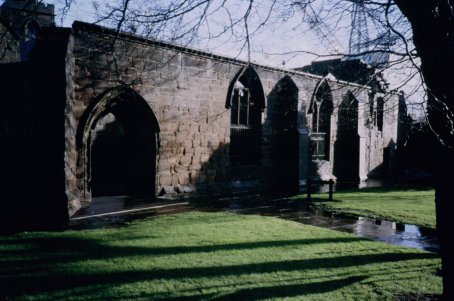
Wyre Heal
A Local History of the Wirral Peninsula
Chapter 13
The Mersey Ferries
There has been a ferry across the River Mersey for well over a thousand years. It is generally accepted that the first ferry was inaugurated by the Benedictine Monks of Birkenhead Priory. In fact, this is not completely accurate. There was a ferry in existence well before the Monks arrived. It ran from a stone slipway situated at Seacombe on an inlet on the northern side of Wallasey Pool close to where Kelvin Road meets Birkenhead Road today. In those days Seacombe consisted of a small collection of cottages that had no other reason for existence other than the ferry and is mentioned in the “Doomsday Book” of 1086.
This ferry may not have been as regular or as reliable as the later Monks’ ferry was but it did pre-date it by about one hundred years. Little documentary evidence is available concerning this ferry except for writings stating that the ferryman charged an exorbitant toll for the crossing and that it was not the most reliable of services. It is safe to assume that the ferry took the form of a rowing boat that carried the passengers across the “narrows” of the river to the vicinity of what was to later become St Nicholas’ Church. This ferry later became a “feeder” for the Monks’ Ferry. The later Monks Ferry used the same location as their Liverpool terminus, either because it already possessed a man-made landing stage or was a natural location that leant itself to the purpose. When the Monks’ Ferry was founded, the original Wallasey Ferry at Seacombe transported passengers to the Priory landing stage in order for them to ferried to Liverpool by the Monks.
Birkenhead Priory was founded in 1150. The Benedictine Monks who lived at the Priory offered food and shelter to travellers on their way to Liverpool. When Liverpool became a Borough in 1207, traffic increased and the unreliability of the existing ferry caused the Monks to start rowing (or, when weather permitted… sailing) travellers over the river using their own boat. By 1330 the Monks’ Ferry was well established and was granted a Royal Charter by King Edward III allowing them to charge a toll for the crossing (the Royal Charter is still in force today).

Birkenhead Priory
King Henry VIII’s religious reforms in 1536 caused the dissolution of the Priory. The Priory buildings including the ferry rights passed to the Crown and were eventually sold to a Ralph de Worsley in 1545. The ferry remained in his family for the next two hundred and eighty eight years. The ferry at Tranmere (close to today’s Woodside Ferry terminus) was leased to John Poole of Sutton by Queen Elizabeth the First in 1586.
There were other ferries established in the Birkenhead area, the history of which is long, protracted, confusing and contradictory (based upon the research that I have made on the subject). It is a subject that has filled whole books and I have no intention of boring the reader with it. The highlights of this history are documented in the chronology at the end of this piece.
The Birkenhead Ferry, as we know it today was inaugurated in 1820 at Woodside. A George la French obtained the consent to start the service by Mr F R Price, who was the then Lord of the Manor. There had previously been a primitive landing stage at this location, which was developed and expanded taking in the existing Tranmere Ferry landing stage.
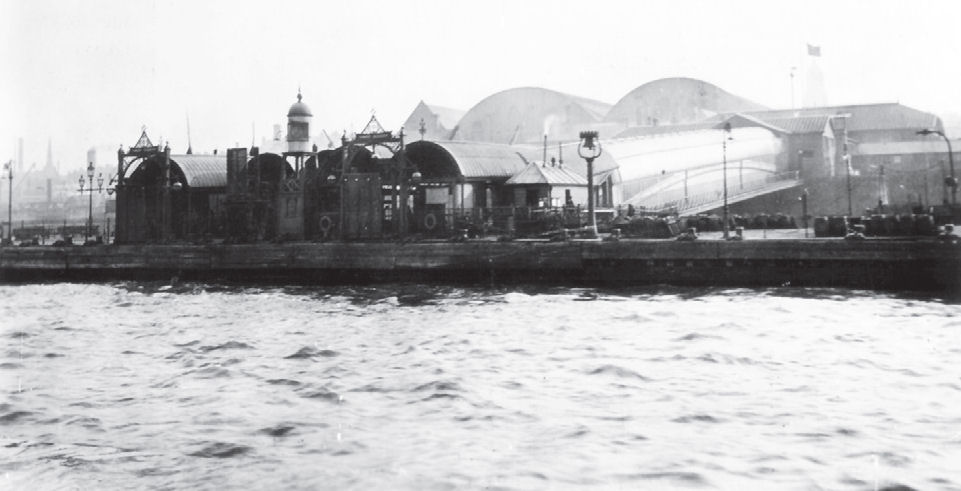
Woodside Ferry in 1910 as seen from the river
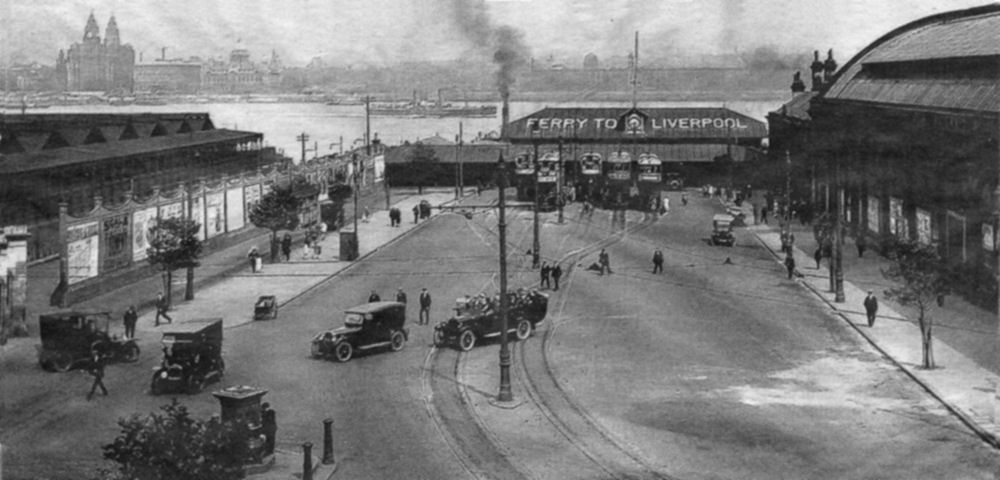
An un-dated photograph of Woodside Ferry Approach probably in the 1920s or 1930s
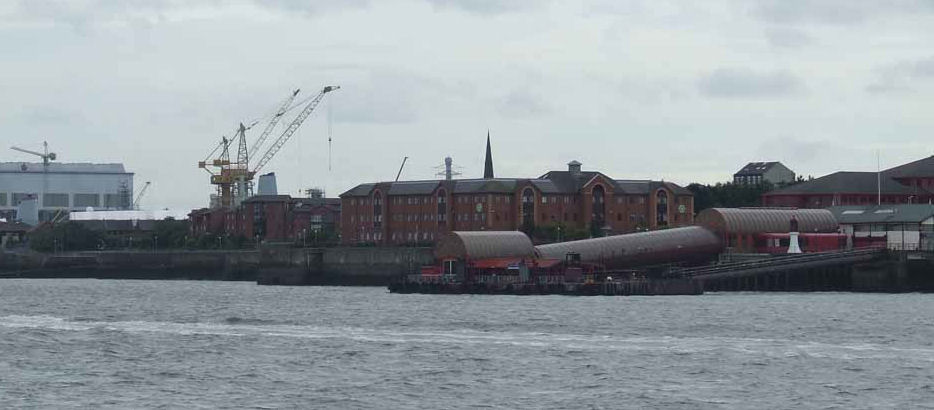
Woodside Ferry in 2007 as seen from the River... Monks' Ferry is on the left, below the two cranes
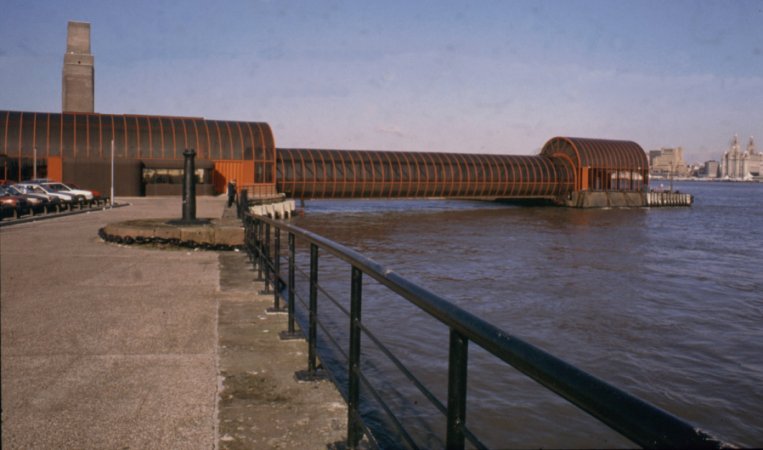
Woodside Ferry in more recent times... 2005
Alderman John Cleveland MP of Liverpool bought the Powell (direct descendants of Ralph de Worsley) Estates that also included the ferry rights in 1833, the same year that Birkenhead Town Council was founded. After this, the ferries lacked stability and structure, changing hands many times. At one point they even belonged to the Birkenhead and Chester Railway Company. By 1842, Birkenhead Council controlled all the ferries except Wallasey, which passed into the control of Wallasey Local Government Board in 1862.
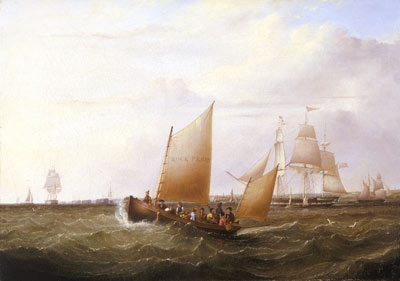
The sail ferryboat "Rock Ferry" was painted by leading marine artist Samuel Walters about 1834
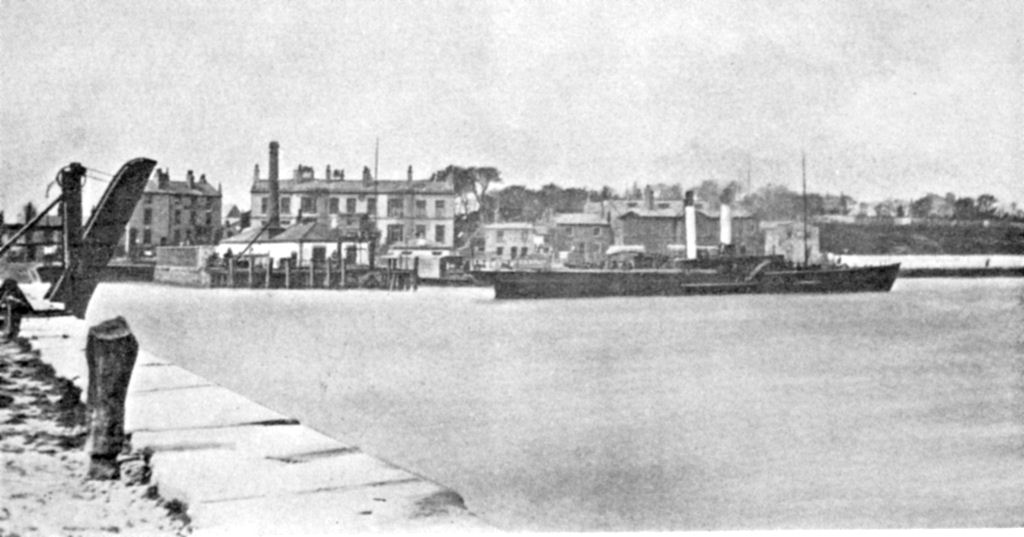
Seacombe Ferry circa 1876
The ferry boats of the time took the shape of large rowing boats capable of carrying thirty passengers and propelled by four oarsmen. The introduction of steam-powered vessels coincided with the ferries acquiring the stability required for a reliable service. Whilst steam powered vessels had previously operated on the river experimentally (the “Etna” in 1817 and the “Gem” of 1820), the first steam powered Mersey ferryboats were wooden paddle steamers called “Royal Mail” on the Birkenhead service and the “Seacombe” on the Wallasey service. Both were introduced the same year… 1822.
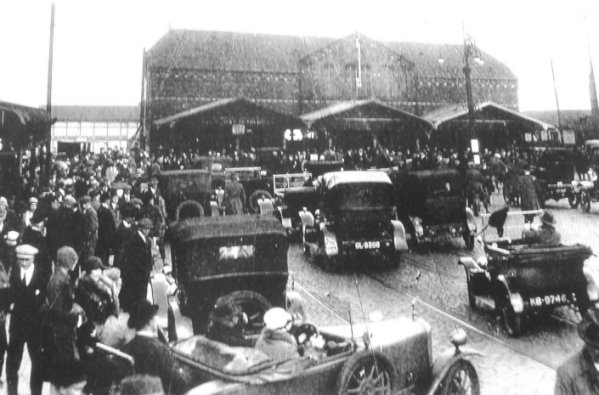
Seacombe Ferry approach before the current Art Deco terminus was constructed
Slowly, the smaller, less popular landing stages that had sprung up (sometimes unofficially and illegally) along the banks of the river as far as Runcorn operated by both Wallasey and Birkenhead started to be closed down. Tranmere Pier was rebuilt as part of the Tranmere Oil Terminal, the original Monk’s Ferry was eventually made into a coaling stage for ferryboats and tugs when it was superseded by a rebuilt Woodside Ferry Landing Stage. In 1939, the Rock Ferry service closed. The ferryboat “Upton” was built specifically for this route and was transferred to the Woodside service. As well as ferry duties, she also acted as tender to the training ship, H.M.S. Conway and the quarantine ships “Akbar” and “Indefatigable” moored in the river above Rock Ferry.
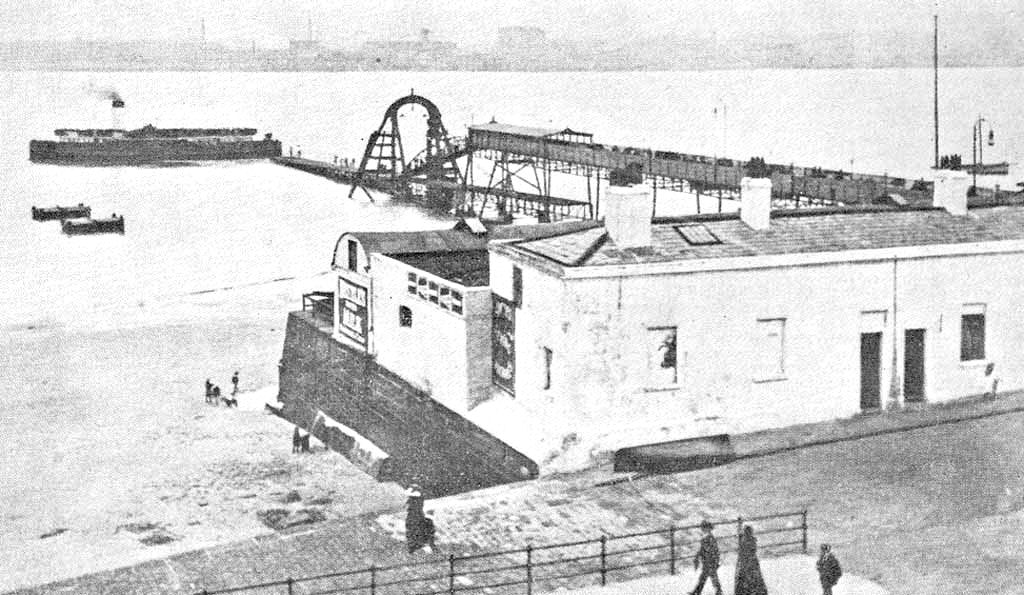
Egremont Ferry in 1895
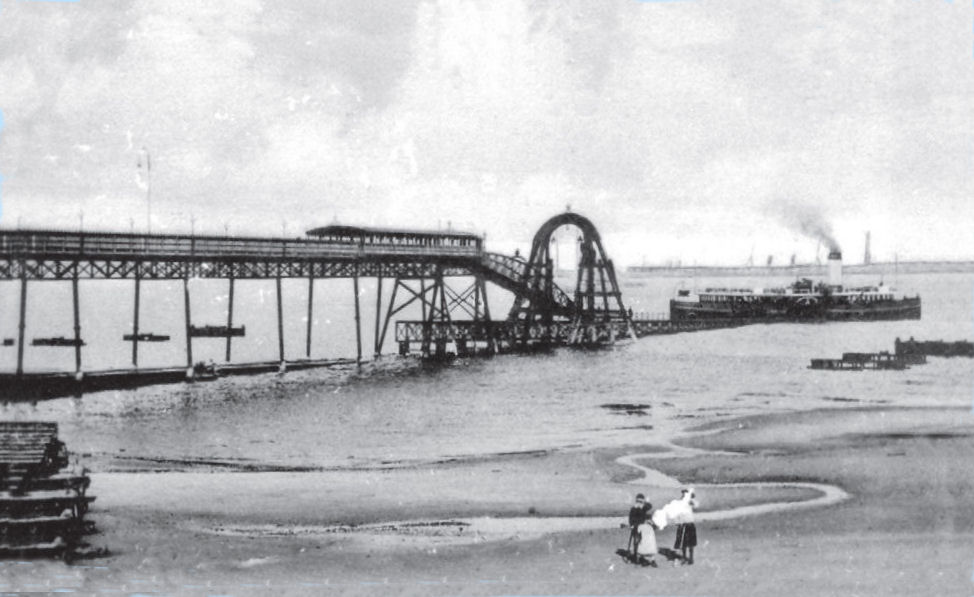
Egremont Ferry in 1904
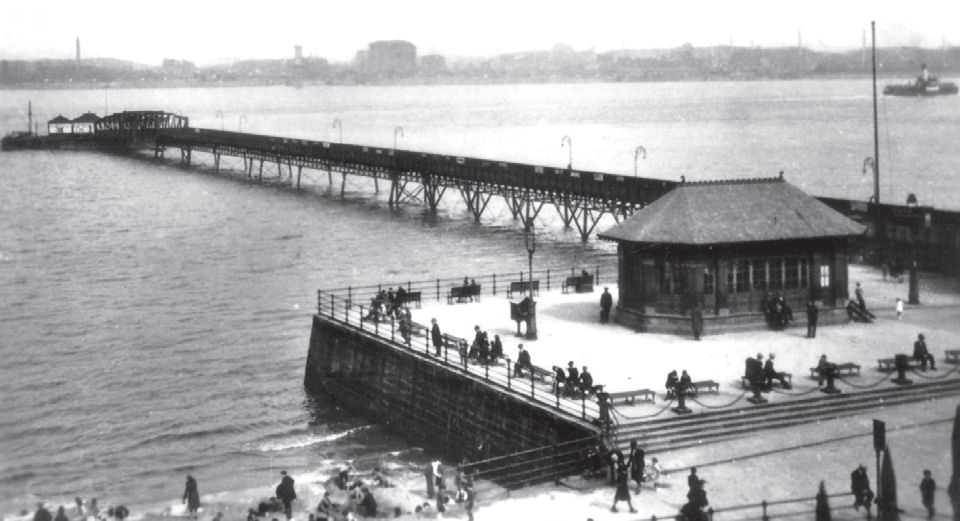
The lengthened Egremont Ferry in the 1930s
The Wallasey Ferry’s three landing stages dwindled to one with the closure of the Egremont Pier stage in 1939 due to a drop in traffic and New Brighton following in 1971 for the same reason. Egremont Pier was rammed by the tanker "Empire Commander" on 21st May 1932 and repaired at a cost of £7340. In 1941 another collision took place when the coaster "Newlands" rammed the pier which was dismantled in 1941. New Brighton landing stage was removed in 1973 and the pier was dismantled in 1978.
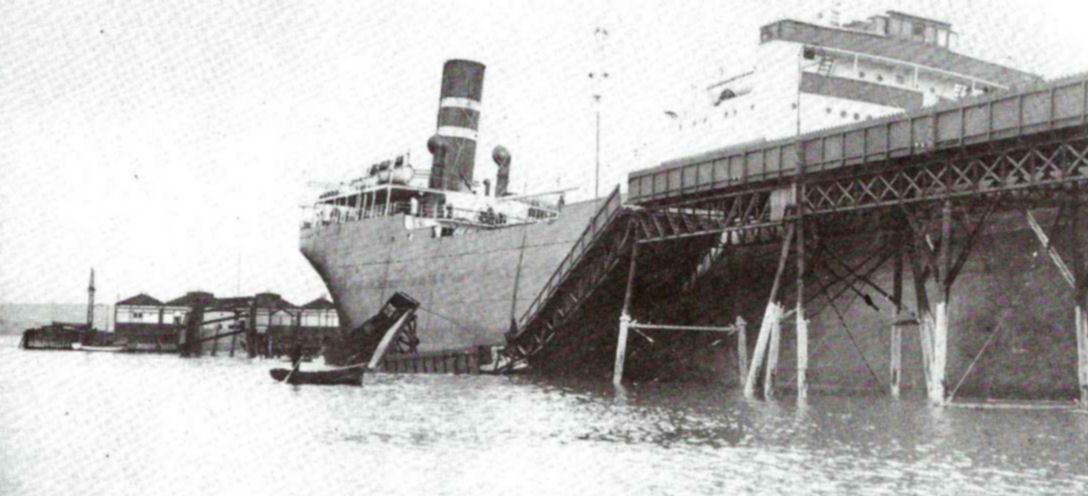
Egremont Ferry after being rammed by the "Empire Commander"
In 1947, Seacombe Ferry became the base for the World’s first commercial radar station. The equipment was supplied by electronics manufacturer; Cossor, and enabled the Wallasey ferryboats to cross the river with complete safety when fog would have previously effected the service. So successful was the installation with it’s large revolving scanner on top of the terminal building’s clock tower, that it was later extended to include the Birkenhead service.
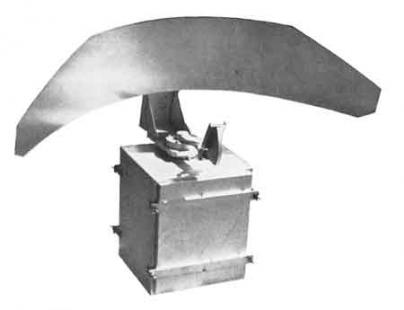
A radar scanner similar to the type used at Seacombe
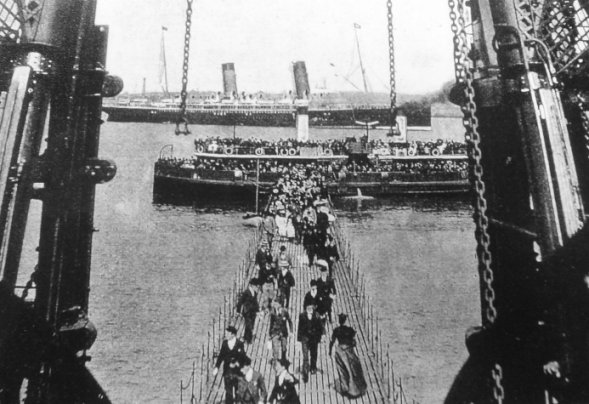
The view down the old Seacombe Landing Stage
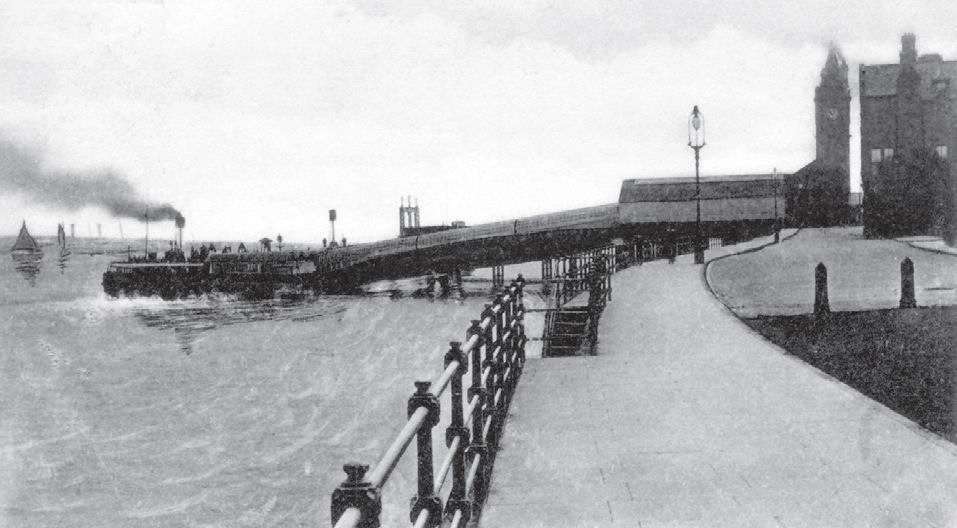
Seacombe Ferry Landing Stage in 1904... this scene is not all that different today
The Wallasey and Birkenhead Ferries were absorbed into Merseyside Passenger Transport Executive in 1969. They continued to operate independently until they were amalgamated in 1974. The Wallasey boats were sold one by one leaving the three Birkenhead craft and Wallasey’s “Royal Iris”. It was decided to operate a triangular service (Seacombe – Woodside – Pier Head) in addition to river cruises and the occasional excursion through the Liverpool Docks Complex or up the Manchester Ship Canal to Salford Quays. The latter is quite a fitting voyage for a Mersey ferry boat as, when the Manchester Ship Canal was opened on the 1st January 1894 the Mersey Ferry Boats "Snowdrop" and "Crocus" were amongst the first craft to sail the complete length of the canal from Eastham to Manchester Docks.
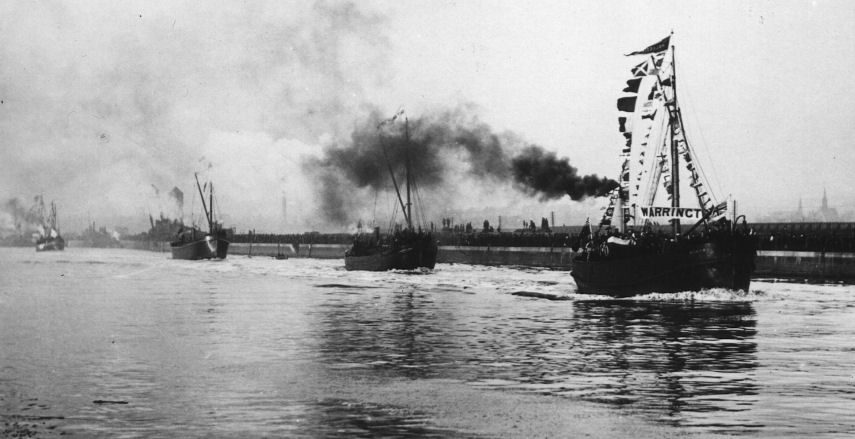
"Snowdrop" and "Crocus" were two of the first craft to sail up the Manchester Ship Canal when it opened on 1st January 1894
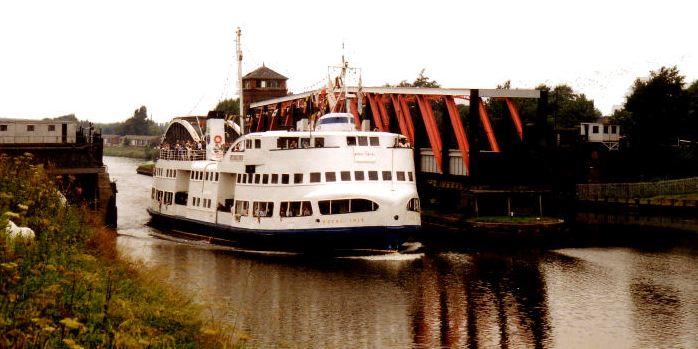
The "Royal Iris" during a cruise up the Manchester Ship Canal at Barton Swing Aqueduct near Manchester in 1987
A new ferry terminus was built at Otterspool Promenade in Liverpool to serve the site of the 1984 International Garden Festival. Due to the lack of depth at that part of the river a channel to the new landing stage was dredged. Even then, the service only operated at high tide. The service was operated almost exclusively by the "Overchurch" but the whole ferry fleet sported a red, white and blue colour scheme. When the Festival was finished, the terminus was dismantled and the site became derelict. In recent years, considerable investment has been made in replacing the original landing stages, Woodside in 1989, Seacombe in 1999 and Liverpool Pier Head in 2012.
The Ferries at War
During both the First and Second World Wars, Mersey Ferry boats saw active duty. In 1917, plans were drawn up to curtail the German U-Boat activities based at Zeebrugge in Belgium. A raiding party was formed which included the Wallasey ferryboats “Iris” and “Daffodil”. They were chosen for their strong double hulls and shallow draught, which would enable them to negotiate enemy minefields with reasonable safety.
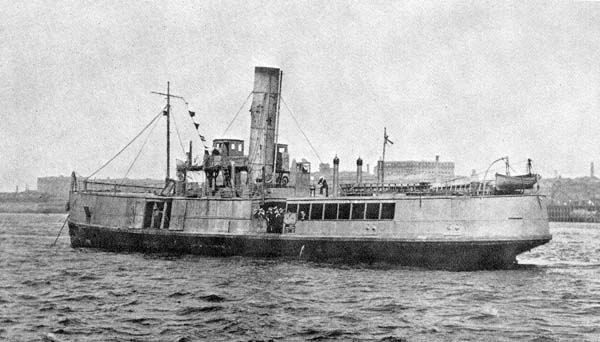
A battered "Iris" in 1918 prior to receiving the "Royal" prefix
They were prepared for war by the fitting of bullet proof plating to their exposed upper decks and padded cladding around the wheelhouses and flying bridges in an effort to help protect against enemy gunfire. They sailed down south to join the rest of the flotilla and on the allotted day, crossed the English Channel to Zeebrugge. Their tasks were to help manoeuvre other craft into position and to carry troops for what was the first Commando raid in history. The raid was a success after which, the valiant ferryboats limped to Dover. Urgent repairs were then made before the duo returned to the Mersey and a hero’s (or should it be heroine’s) welcome.
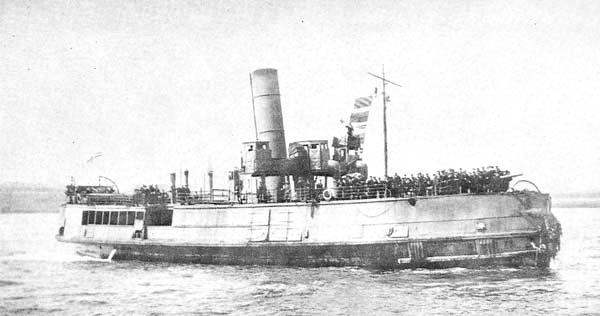
A not quite so battered "Daffodil II" on her return from Zeebrugge
In recognition of their gallant contribution to the war, King George V recommended that the names of the ferryboats be changed to “Royal Iris” and “Royal Daffodil”. For many years, the bullet-holed funnel of the “Royal Daffodil” was on display at Seacombe Ferry.
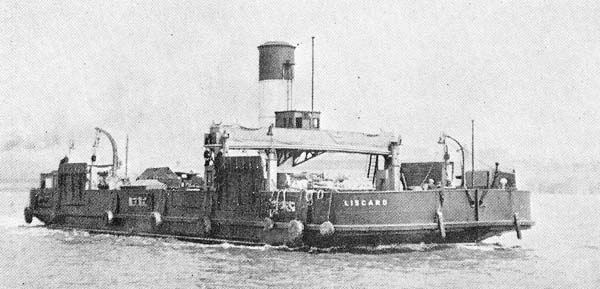
The "Liscard" Luggage Boat prior to modification for WWII
During the Second World War, the Birkenhead luggage boats “Bebington”, “Oxton” plus Wallasey’s “Liscard” were fitted with large cranes on their wide, open decks. They were then used for unloading cargo and aircraft necessary for the war effort from the decks of merchant ships in the Mersey. The “J Farley” and “Francis Storey” were also commandeered. They were both employed in laying torpedo nets, the “Francis Storey” was based secretly at a location somewhere in Liverpool Bay and the “J Farley” went to Milford Haven and the River Clyde. The “Royal Daffodil was used as a troopship support vessel, standing by in full steam at Seacombe should one of the troop ships moored in the Mersey suffer a direct hit from enemy bombers. This would have necessitated their subsequent rescue and evacuation.
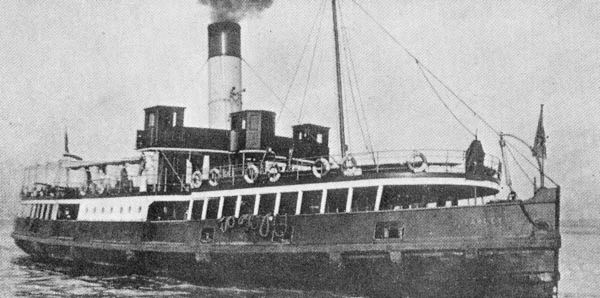
The "John Farley"
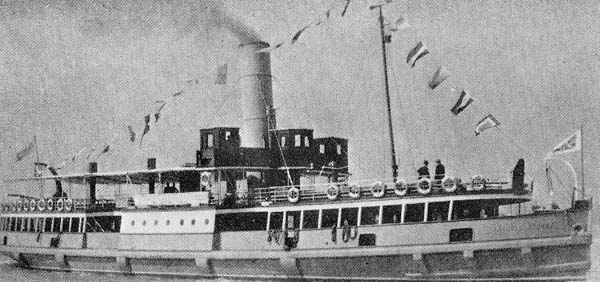
The "Francis Storey"
It was during one of these periods in 1941 that the “Royal Daffodil” herself received a direct hit at Seacombe Landing Stage. Thankfully, there were no casualties although; the engineer did lose his false teeth as he was blown against a bulkhead during the blast from the bomb, most of which went up the funnel. She remained where she sank at Seacombe for more than a year until, after great difficulty (due to the amount of silt that had collected inside her) she was raised and rebuilt, returning to service in 1943. The “Upton”, meanwhile, was used to service the many anti-aircraft defence units situated throughout the Liverpool Bay and North Wales coastal area.
More Recent Wallasey Ferries
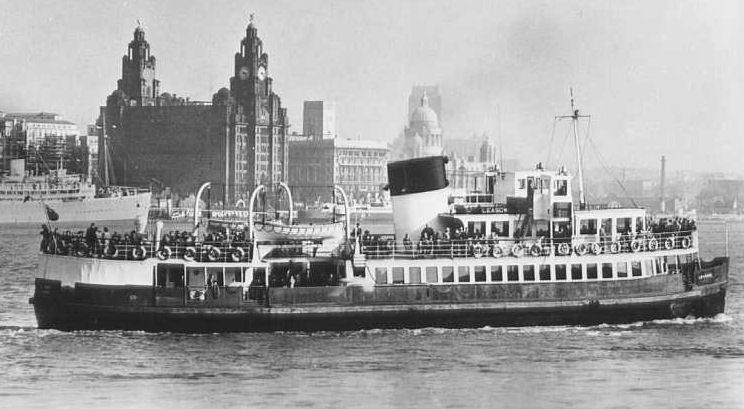
Leasowe
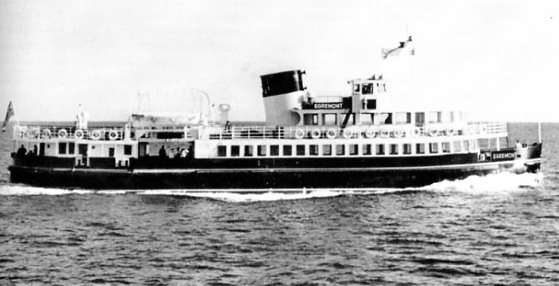
Egremont
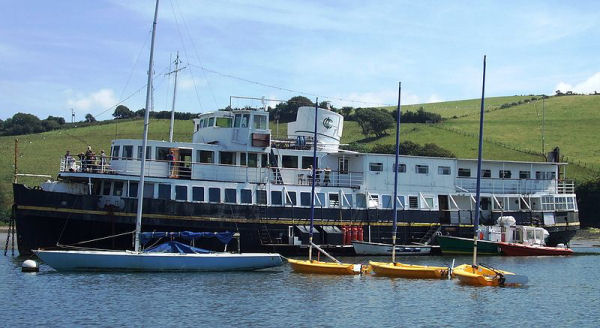
Egremont at Salcombe
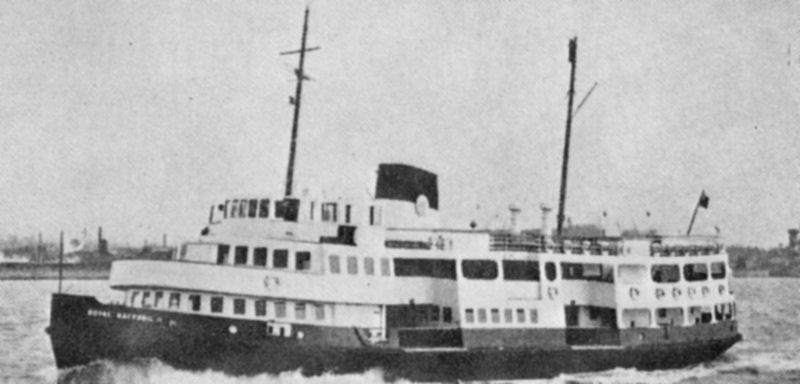
The "Royal Daffodil II"
More Recent Birkenhead Ferries
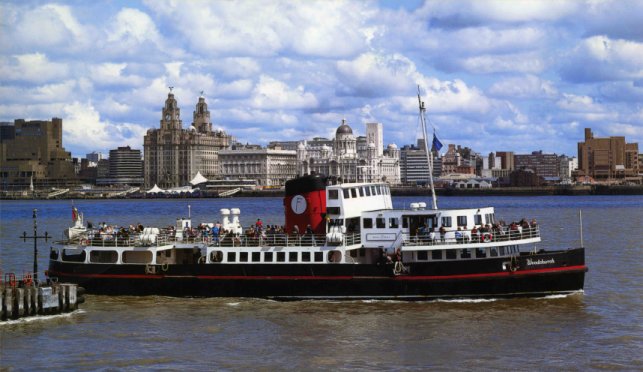
"Woodchurch" leaving Woodside
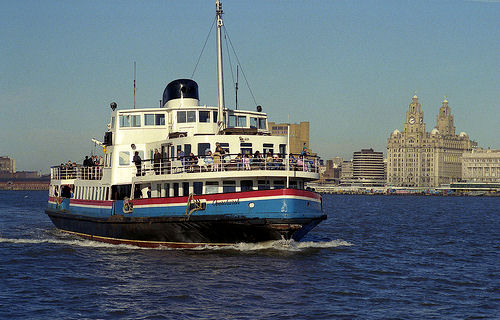
"Overchurch" in the 1984 "Royal" paint scheme approaching Woodside
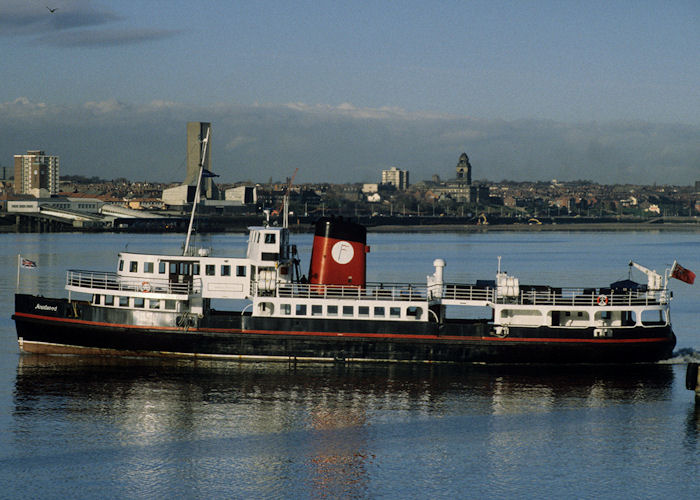
"Mountwood" leaving Liverpool Pier Head
The “Royal Iris”
One of Wallasey Ferry’s most famous and favourite craft was the 1951 “Royal Iris”. She was the third ferryboat to posses this name, the first diesel-electric craft to operate as a Mersey ferryboat and was built by Denny’s of Dumbarton for Wallasey Corporation at a cost of £400,000. Her primary function was that of a cruise boat but she did operate as an ordinary ferryboat when required. In the early nineteen seventies, she starred in a Saturday morning children’s TV series called “The Mersey Pirate”. For the series, an odd-looking structure was added to her top deck, which was supposed to be the “pirate’s” lookout. When the series ended, the structure was removed.
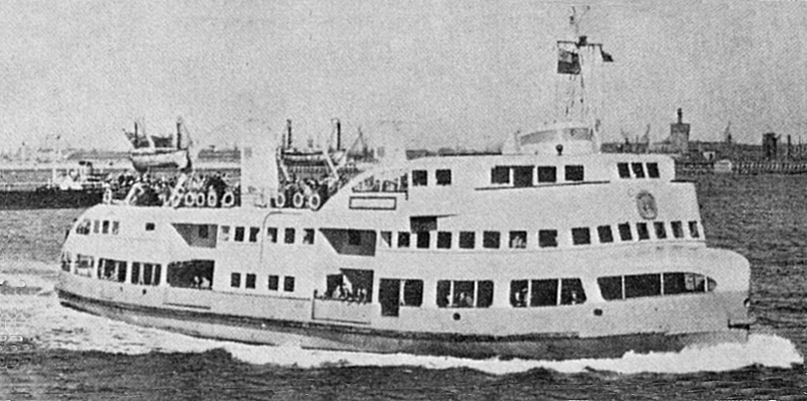
The "Royal Iris" in the early 1950's sporting her original green and beige paintwork
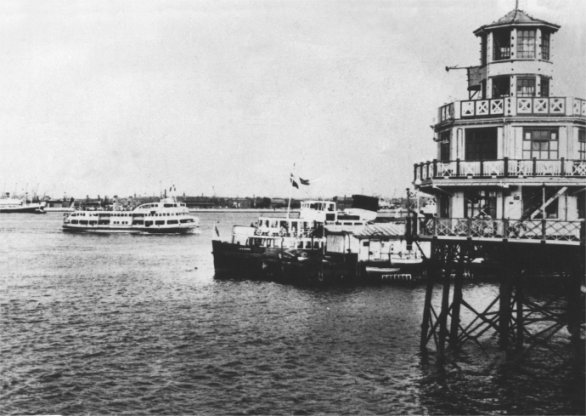
The Royal Iris approaching New Brighton Pier where either Leasowe or Egremont is about to leave
She has been an ambassador for Liverpool and the Merseyside area on many occasions and in May 1985, even went as far as London for a Merseyside promotion, mooring on the River Thames close to H.M.S. Belfast. This was to be the only time that she left the Mersey during her career as a ferryboat.
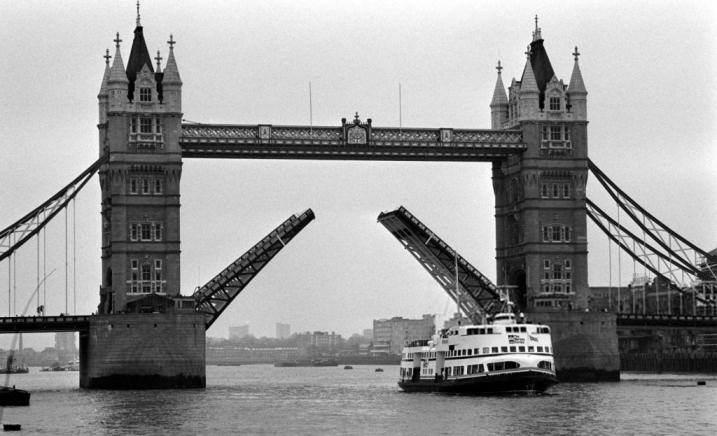
The Royal Iris passing Tower Bridge on the River Thames in 1985
Her nickname was the “Fish and Chip Boat” due to having a restaurant on board that sold excellent fish and chips during the evening dance cruises. An alternative nickname was the “Booze Boat” as there was also a bar on board. When the “Q.E.2” first came to the Mersey in 1990, the “Royal Iris” was used as a tender, ferrying dignitaries and passengers alike to and from the giant ocean liner. Sadly, she was retired soon afterwards and put up for sale. An unusual spin-off from the "Royal Iris" was a Wallasey Corporation Motors bus styled similarly to the ferry boat. It travelled far and wide promoting the area and the ferries.
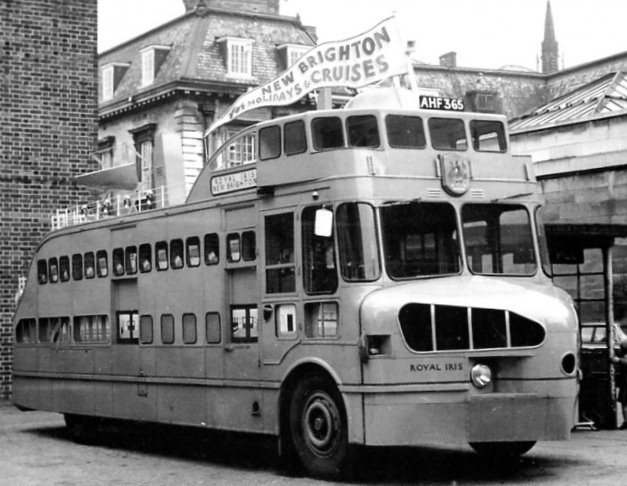
Wallasey Corporation Motors' "Royal Iris" bus
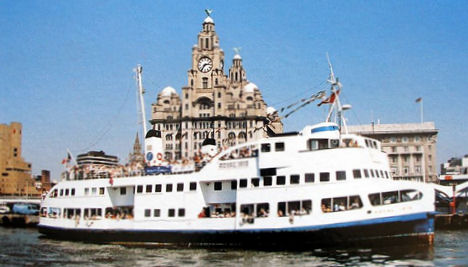
The "Royal Iris" in the Merseytravel colour scheme in front of Liverpool Pier Head
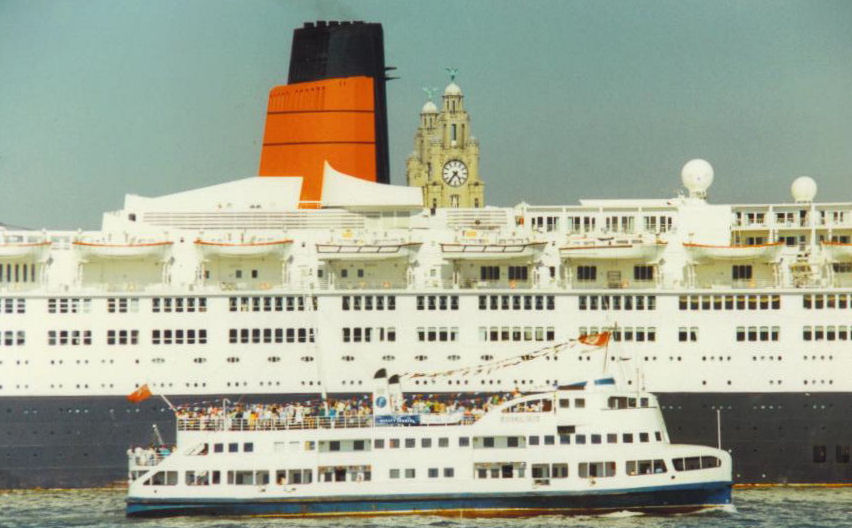
The "Royal Iris" dwarfed by the "QE2" in 1990
After lying in Birkenhead docks, mothballed, she was eventually sold and her new owners had plans for converting her into a floating nightclub and conference centre in Liverpool’s Stanley Dock, to where she was moved. This was to be the last time that she sailed under her own power and on leaving the entrance locks at Birkenhead, Captain Peter “Paj” Jones turned her to pose for the many photographers (myself included) and onlookers who had gathered to witness the sad event. It must have been an act of defiance when, halfway across the river, one of her engines failed and she limped into Stanley Dock unaided.
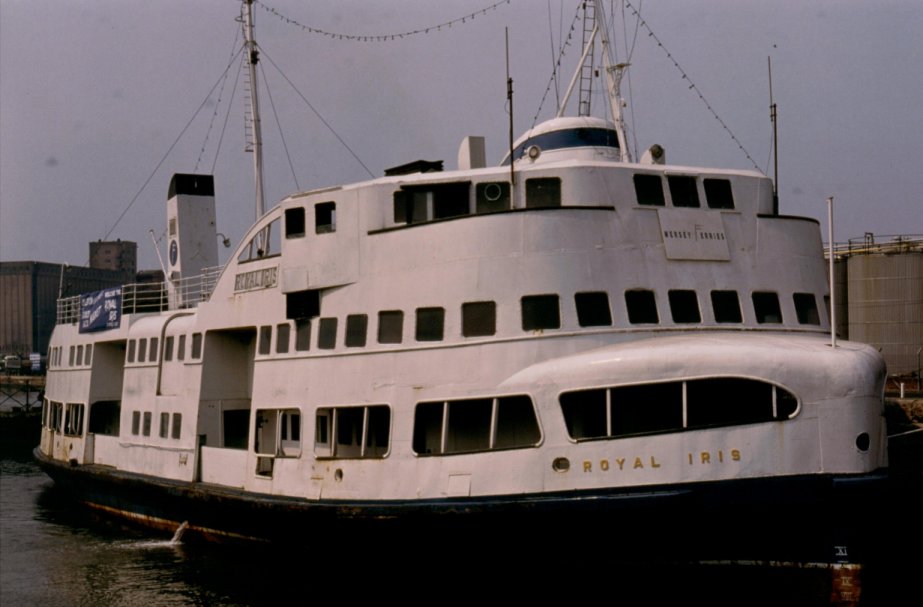
The Royal Iris leaving Birkenhead Docks for the last time
The nightclub and conference centre plans didn’t work out and on the 23rd August 1993 she was towed to Cardiff, South Wales for a similar venture, which also collapsed. On the day that she was towed to her new home, she left Stanley Dock and the tug towed her upstream past the Princess Landing Stage for the last time. The fog bell tolled mournfully and the ferryboat on duty sounded her horn as a farewell gesture. After passing the Pier Head the “Royal Iris” was towed across the river to the Wallasey side and passed the Seacombe landing stage before heading downstream and out of the Mersey forever.
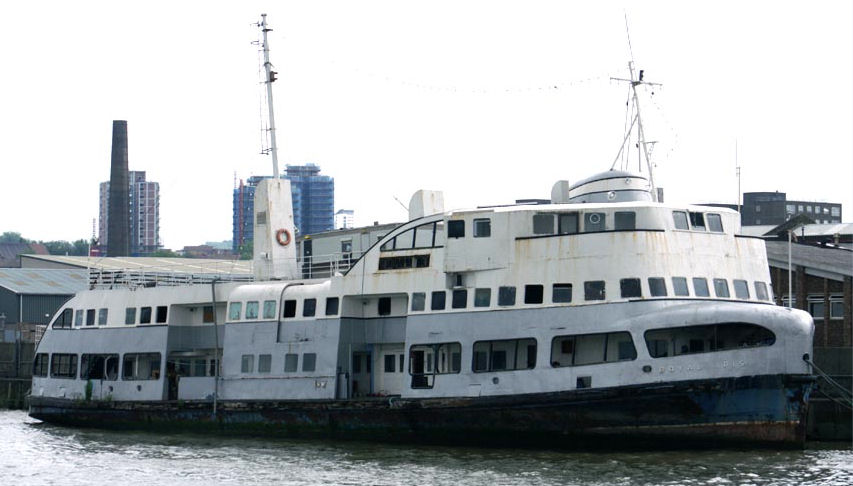
A scruffy looking "Royal Iris" moored at Woolwich on the River Thames adjacent to the Thames Barrier...
At the time of writing (April 2019) she is lying derelict in tidal moorings on the mud banks just downstream from the Thames Tidal Barrier awaiting her fate. It would be a fitting tribute to her if she was brought back to the Mersey and installed in Liverpool’s Maritime Museum dry-dock, next to the pilot boat as an exhibit containing the history of the ferries. There are doubts as to whether or not she would pass through the Albert Dock’s entrance lock but, even if she was too wide in the beam for the lock, there are other nearby locations that could offer her a suitable home. Unfortunately, she needs a complete new bottom and neither of her engines work. It would require considerable funding to purchase her from her present owners and either make her seaworthy to bring her back to the Mersey and return her to her former glory, which makes either option an uneconomic proposition. It is doubtful if a new owner can be found and she will, in all probability end up in the breakers’ yard in the not too distant future.
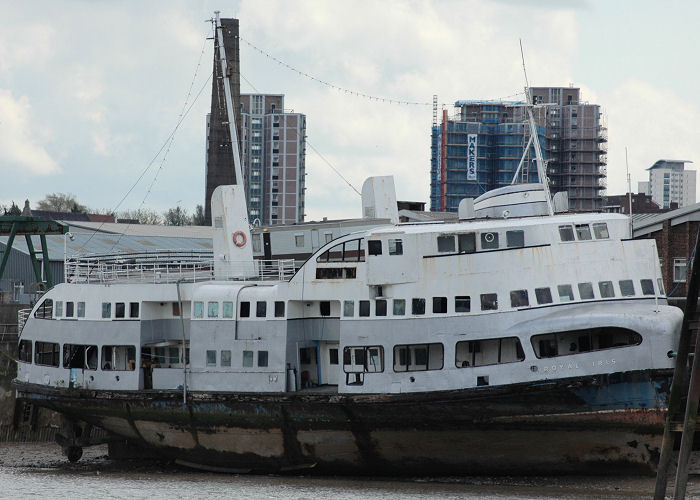
...and sitting on the mud at low tide on her Woolwich mooring
In February 2010 I was alerted to the fact that the "Royal Iris" was sinking by Andrew Morgan... a fellow local history enthusiast and regular visitor to this website. The "Iris" was taking on water with every high tide, was sitting very low in the water and had been attended to by the Gravesend Lifeboat and the River Thames Police for fear that there were people trapped onboard. The sinking was reported in the local press and their were calls for the craft to be brought back to the Mersey. Unfortunately, the necessary cash was not available. Since writing the above it has come to light that volunteers have been on board the "Iris" and have fixed the problem that allowed water to enter the boat when the tide came in but betwen then and now another leak has occurred and the "Royal Iris" is swamped twice a day when the tide comes in.
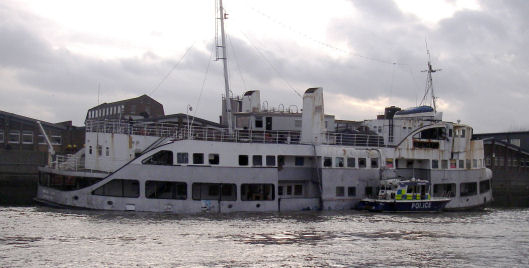
The semi-derelict "Royal Iris" sinking in early February 2010
(Photograph - RNLI)
There is currently a website dedicated to the rescue of the "Royal Iris" produced by Dave Wood (no relation). On this website are stunning recent photographs taken on board as well as the opportunity to sign a petition to save her. The web address is as follows... http://www.royaliris.co.uk/gallery/. Also, an anonymous Wirral business man has been in negotiations with the "Royal Iris's" owner with a view to purchasing her, making her sea worthy and bringing her back to the Mersey. Unfortunately, I do not think that this will happen and her next journey will be to the breakers yard. In 2016 I was in London for a Convention at the Exel Conference Centre not too far away from the Thames Barrage. I walked down to the River Thames and saw, on the opposite bank the "Royal Iris" looking very sorry for herself. The writing is now on the wall for the "Royal Iris" and, as I mentioned earlier, I do not think that it will be too long before this once beautiful icon of the River Mersey ends her days shamefully in a breakers' yard.
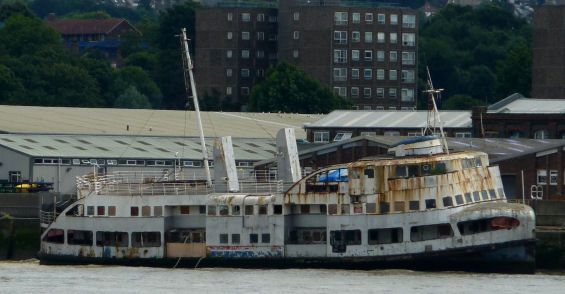
The "Royal Iris" today... totally derelict and sunk
Experimental Craft
On a few occasions, non-ferry craft have operated the service across the Mersey in order to evaluate their suitability on the service. Such a craft was the "Channel Belle"... an ex-naval Fairmile Launch more at home in the Devon and Cornish bays than the unpredictable River Mersey. This craft was used for a number of years from 1949 to 1953. She was eventually sold as a leisure cruiser when she reverted back to her original name.

The Fairmile Launch - "Channel Belle"... later renamed temporarily "Wallasey Belle"
Another experimental craft was the “Highland Seabird”, a high-speed catamaran, which was leased to the Ferries and used for a short while in 1982. Like the "Channel Belle" she was small, highly manoeuvrable and very economical. It was hoped that this type of craft, if the trials were successful, would form the next generation of ferry boats but unfortunately, her size and stability (or lack of) especially in rough weather, were her downfall. On one occasion, when operating in gale force conditions, she became trapped behind the Princess Landing Stage at Liverpool’s Pier Head and the “Royal Iris” came to her (and her passengers’) rescue. Needless to say, the trials were unsuccessful. Soon after she was returned to her owners. Hovercraft have also been tried on the service but they also proved to be unsuccessful.
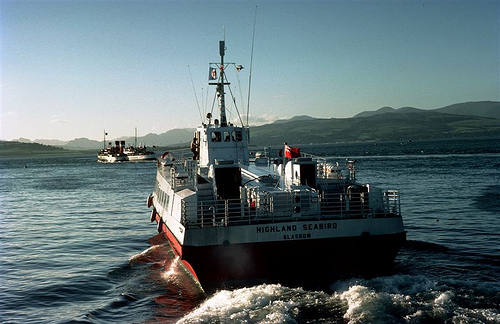
The "Highland Seabird" high speed catamaran... another unsuccessful experiment
(Photograph - Degahk Flickr Photostream)
There have been many threats to the Ferry’s existence over the years… railway and road tunnels (which robbed the ferries of foot passengers and road vehicles on the “luggage Boats”), bridge and barrage plans to span the estuary carrying a road on top of it that never materialised and the threatened closure in 1977 by MPTE due to financial losses. With regard to the latter, due to the 1330 Royal Charter still being in force, an act of Parliament was promoted by the MPTE to “authorise the discontinuation of the Mersey Ferries”. Local MP Frank Field took an active part in the proceedings and the bill ultimately failed. This failure secured the immediate future of the ferries.
The Ferries Today and Tomorrow
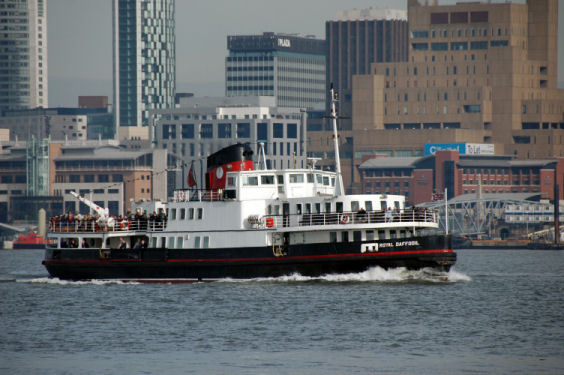
"Royal Daffodil" (III) - formerly the "Overchurch"
The three craft remaining in service today are... “Royal Daffodil”, (formally the “Overchurch” - renamed in 2000) built by Cammell Laird of Birkenhead and the first Mersey ferryboat of all welded construction, “Royal Iris of the Mersey", (formally the “Mountwood” - renamed in 2002) and the "Snow Drop" (formally the “Woodchurch” - renamed in 2004). The latter two being the “twins” built by Philip and Son of Dartmouth, which have been in operation since 1960, and the “Royal Daffodil” came into service two years later in 1962. Now over fifty years old, although in good condition, regularly dry-docked and refitted, consideration may now have to be made as to the future of these craft and what will take their place when they eventually reach the end of their lives.
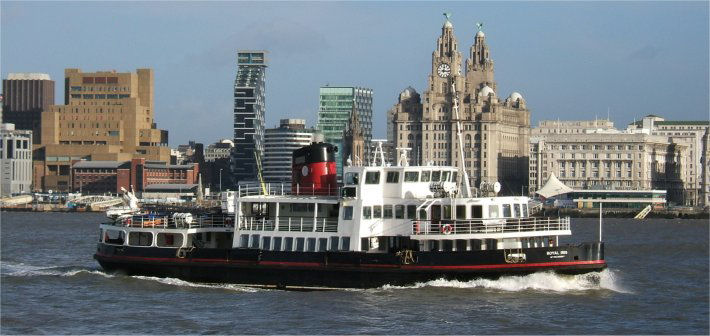
"Royal Iris of Mersey" - formally "Mountwood"
In 2001 the “Mountwood” was taken out of service to be refitted and re-engined by Cammell Lairds at Beyer and Wright’s Bidston dry-dock. Cammell Lairds went into receivership before the refit was completed. This was subsequently completed by Mersey Ferries’ engineers at Western Ship Repairers’ Bidston Dry-dock and when she was relaunched at their moorings adjacent to Duke Street Bridge, Birkenhead. Prior to returning to service, she was renamed “Royal Iris of the Mersey”.
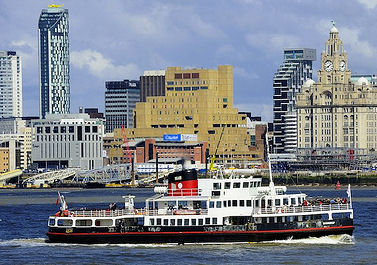
"Snowdrop" - formerly "Woodchurch"
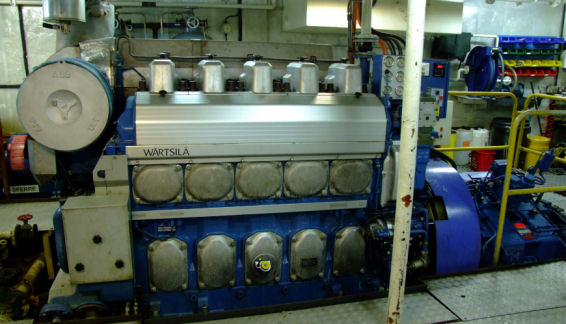
One of the Wartsilla 9R32 engines fitted to "Snowdrop" during her re-fit
It is ironical that the complete fleet of ex-Birkenhead Ferries craft have now been renamed after previous members of the Wallasey Ferries fleet... arch-rivals in their heyday.
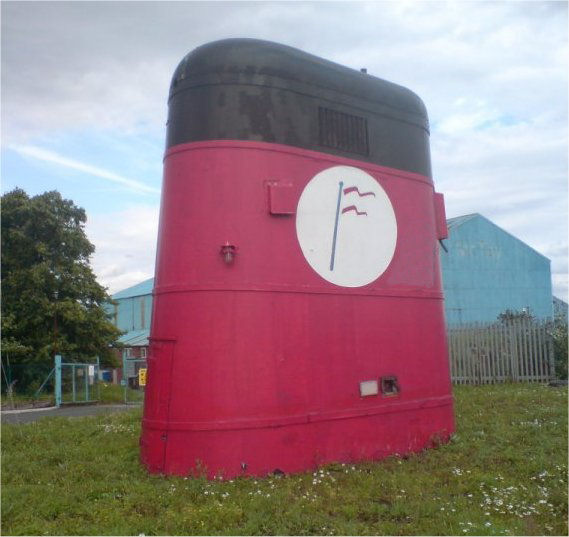
The original funnel from "Woodchurch" after being refitted and renamed "Snowdrop" in 2004, located in Bromborough
Experiments with craft such as the “Channel Belle” of 1949 (“Wallasey Belle”), the “Highland Seabird” of 1982 and the hovercraft have proved that smaller craft are unsuitable for the Mersey Ferry service. There is a case for the existing craft being refitted again and again but as new legislation and specifications are introduced, their implementation on the current fleet becomes increasingly more difficult and expensive. Maybe their successors will not be all that far removed, design-wise, from the craft in service today.
Chronology of the Mersey Ferries
|
Pre- 1089 |
A ferry of sorts ran from Seacombe on Wallasey Pool to a landing stage in Liverpool. The ferry eventually became a “feeder” for the Monk’s Ferry. |
|
1150 |
Birkenhead Priory established on “The Headland of the Birches”, a promontory jutting out into the River Mersey. |
|
1207 |
Liverpool became a Borough possessing an administrative corporation. |
|
1266 |
The Crown grants ferry rights to Edmond, Earl of Lancaster, to operate a ferry from Liverpool to Claughton (possibly Wallasey Pool). |
|
1318 |
First Royal Charter bestowed by King Edward III allowing the Monks to build a lodging house for passengers awaiting the ferry, to supply them with refreshments during this period and to charge for both services. |
|
1330 |
Second Royal Charter bestowed by King Edward III allowing the Monks to operate a ferry service and to charge reasonable tolls. |
|
1365 |
Bromborough and Eastham (Carlett or Job’s) ferries indicted for running ferries without a licence. |
|
1536 |
Dissolution of the Priory due to King Henry VIII’s religious Reforms. |
|
1537 |
Tenure granted to the Molyneux Family by Liverpool Corporation to operate the Liverpool Ferry. |
|
1541 |
Seacombe Ferry leased to William Bromley. |
|
1545 |
Ralph de Worsley becomes owner of the Priory estates including the ferry. |
|
1572 |
Liverpool Ferry operated a service to Chester, Eastham (Carlett or Job’s) and Warrington. |
|
1584 |
First records of a ferry at Woodside being in existence. |
|
1586 |
Queen Elizabeth I leases Tranmere Ferry to John Poole of Sutton. |
|
1753 |
Records show that ferries were in existence at Seacombe, Woodside, Monk’s, Tranmere, Rock Ferry, Eastham (Carlett or Job’s), Ince, Runcorn and Warrington. There were also “unofficial” ferries such as the one that ran from what was to become New Ferry at Bromborough Pool. |
|
1762 |
Coaches started to run to Woodside Ferry from Chester and Parkgate. |
|
1789 |
Liverpool ferryboats prevented from landing at Birkenhead. |
|
1817 |
The paddle steamer, “The Etna” was used experimentally on the ferries. |
|
1820 |
Inauguration of Birkenhead Ferry at Woodside. |
|
1822 |
Introduction of the first steam-powered Mersey ferry boats… the “Royal Mail” for Birkenhead and the “Seacombe” for Wallasey. |
|
1826 |
New quay built at Woodside. |
|
1830 |
Local businessman James Atherton bought land in what is now New Brighton to build a holiday resort and Egremont Ferry opens to rival Seacombe. |
|
1833 |
Alderman John Cleveland MP purchases Birkenhead Ferry Rights. |
|
1835 |
Woodside, North Birkenhead and Liverpool Steam Ferry Company formed. |
|
1840 |
Woodside Ferry closed due to legal battle and Monk’s Ferry ceases to operate. |
|
1841 |
Liverpool Corporation purchases Birkenhead Ferries. |
|
1842 |
Woodside Ferry and buildings leased to Birkenhead and Chester Railway Company and an Act of Parliament allowing the formation of the Birkenhead Ferries. |
|
1845 |
New Ferry to Liverpool service commences from Bromborough Pool. |
|
1847 |
The St George’s Landing Stage in Liverpool was completed. |
|
1858 |
Completion of the purchasing of the ferries by the Commissioners of Birkenhead. |
|
1861 |
The construction of the new floating landing stage at Woodside was completed and subsequently opened. |
|
1867 |
New Brighton Pier constructed. |
|
1870 |
Birkenhead Ferry offered for sale on a 999-year lease. No offers were received and the ferry was abandoned. The site is now part of Cammell laird’s Shipyard. |
|
1876 |
Princess Landing Stage in Liverpool, the largest floating structure at that time in the World (nearly half a mile long), was opened. |
|
1877 |
Birkenhead becomes a County Borough to which the ownership of the ferries was transferred. |
|
1879 |
First purpose built vehicle ferry (Luggage Boat) the “Oxton”, went into service from Woodside. |
|
1886 |
The Mersey Railway opened causing ferry traffic to temporarily slump. |
|
1894 |
01/01/1894: "Snowdrop" and Crocus were amongst the first craft travelling along the Manchester Ship Canal on it's opening day. |
|
1899 |
Rock Ferry Pier and Landing Stage constructed. |
|
1909 |
New floating landing stage built at Egremont. |
|
1918 |
The Birkenhead Ferryboats “Iris” and “Daffodil” go to war with the Royal Navy at the Zeebrugge landings in Belgium. |
|
1921 |
New Brighton Landing Stage, at the end of the pier, enlarged. |
|
1925 |
New landing stage constructed at Seacombe Ferry. |
|
1929 |
Eastham Ferry closes. |
|
1932 |
The oil tanker “British Commander” crashes into Egremont Pier causing the ferry service to be suspended, and possibly closed. |
|
1933 |
Due to local pressure, the ferry at Egremont was rebuilt and reopened. New ferry buildings and approach area built at Seacombe Ferry. |
|
1934 |
Queensway, the first road tunnel beneath the Mersey opened causing a slump in the luggage boat traffic. |
|
1938 |
Electrification of the West Kirby and New Brighton Railway lines effects ferry traffic to Egremont and New Brighton. These services were only run in season from then on until their eventual closure. |
|
1939 |
Egremont and Rock Ferry services cease operation. |
|
1941 |
Egremont Pier damaged by the coaster “Newlands” running into it. Ferry boats commandeered by the Admiralty for war work and the “Royal Daffodil II” bombed and sunk at Seacombe Ferry. |
|
1942 |
Luggage boats commandeered by the Admiralty for war work. |
|
1943 |
“Royal Daffodil II” returned to service after being rebuilt. The “Francis Storey and the “J Farley” commandeered by the Admiralty for laying torpedo nets. |
|
1947 |
All Wirral luggage boat services are discontinued and the World’s first commercial radar station is installed at Seacombe Ferry. |
|
1949 |
Fairmile launch “Channel Belle” is bought by Wallasey Ferries, renamed “Wallasey Belle” and used for the night service. Egremont Ferry and Pier dismantled. |
|
1951 |
The revolutionary diesel-electric “Royal Iris III” built by Denny’s of Dumbarton, (the “Fish and Chip Boat” or “Booze Boat”) launched and brought into service. |
|
1953 |
“Wallasey Belle” sold due to being too small. |
|
1955 |
Wallasey and Birkenhead floating roadways closed. |
|
1960 |
New Brighton landing stage is rebuilt. MV “Woodchurch” and MV "Overchurch” built by Philip and Sons of Dartmouth and put into service. |
|
1962 |
The new bridge at New Brighton landing stage collapses and subsequently raised by the floating crane “Mammoth”. “Overchurch” carries dignitaries to open Cammell Laird’s new dry dock adjacent to Birkenhead Priory. An experimental hovercraft service operated from Leasowe to North Wales for one season only and the River Mersey freezes over in Winter causing little or no disruption to the ferry services. The MV “Mountwood”, of similar design to the “Phillips Twins”, built to the same plans by Cammell Laird of Birkenhead, except for being of all-welded construction (a first for the Mersey Ferries) went into service. |
|
1966 |
The film “Ferry Across the Mersey”, starring Gerry Marsden, focuses attention on the Mersey Ferries. |
|
1969 |
Formation of Merseyside Passenger Transport Executive. |
|
1971 |
Last ferry to New Brighton after which the Pier and Landing Stage was closed. “Royal Iris” refitted and painted in new blue and white livery. |
|
1973 |
New Brighton landing stage is removed. |
|
1974 |
Mersey Tunnel subsidy to the ferries ends causing Wallasey and Birkenhead Ferries to merge, Birkenhead boats use Seacombe landing stage for the first time. |
|
1975 |
New concrete floating landing stage constructed at Liverpool’s Pier Head. |
|
1976 |
New landing stage at Liverpool sinks causing the ferries to use the Princes Landing Stage next door. |
|
1977 |
Queen Elizabeth sails on the “Royal Iris”, MPTE promoted an Act of Parliament for “the discontinuance of the Mersey Ferries” which failed and the “Friends of the Ferries” formed. |
|
1978 |
New Brighton Pier demolished. |
|
1982 |
“Highland Seabird” catamaran is chartered for trials on the Ferry Service. She was caught behind the Princess Landing Stage at Liverpool and rescued by the “Royal Iris”. The trials were deemed unsuccessful and the craft returned to her owners. |
|
1984 |
New ferry landing stage built at Otterspool to serve the International Garden Festival built. The ferry boats were painted red, white and blue. The ferry service was only operational at high tide and closed later on in the year. |
|
1985 |
“Royal Iris” visits London on a publicity promotion for Merseyside and has the honour of Tower Bridge opening for her. |
|
1989 |
New Woodside Landing Stage opened. |
|
1990 |
“QE2” visits the Mersey for the first time and the Mersey Ferryboats (including the “Royal Iris” prior to retirement) act as tenders to the liner. |
|
1991 |
“Royal Iris” sold and moved to Stanley Dock in Liverpool and the café and aquarium added to Seacombe Ferry terminal. |
|
1993 |
“Royal Iris” sold again and towed out of the Mersey to Swansea. |
|
1999 |
New Seacombe Landing Stage opened and the “Royal Iris” is towed to the River Thames to be sold yet again. She subsequently ended up close to the Thames Barrier at Woolwich semi derelict. |
|
2000 |
“Overchurch” refitted and renamed “Royal Daffodil”. |
|
2001 |
“Mountwood” re-engined and refitted but work interrupted by Cammell Laird going into receivership and subsequently being sold. The work was completed by the Mersey Ferries Engineering Staff at Clarence Dry-dock, Liverpool (where she spent nine months) and the Mersey Ferries berth at Duke Street Bridge, Birkenhead. |
|
2002 |
Royal Iris towed to Woolwich on the River Thames. Refitting of “Mountwood” completed and renamed “Royal Iris of the Mersey” on 21st March and put back into service at Easter leaving the “Woodchurch” the only member of the fleet retaining it’s original name. |
|
2004 |
"Woodchurch" refitted and renamed "Snowdrop" on 19th August at Liverpool Pierhead. |
| 2008 | The new Floating Ferry Stage completed and in service. |
| 2009 | U543 Appreciation Centre opened at Woodside and the new ferry terminal building at Liverpool Pier Head completed. |
| 2010 | "Royal Iris" reported as sinking on the River Thames close to the Thames Barrier at Woolwich. Repaired but left derelict. |
| 2012 | New Liverpool Pier Head Landing Stage opened. |
| 2013 | "Overchurch" moth-balled and moored adjacent to Duke Street Bridge, Birkenhead. |
| 2015 | "Snowdrop" painted in Sir Peter Blake's "Razzle Dazzle" paint scheme inspired by the World War 1 "dazzle" camouflage |
| 2019 | "Overchurch" sold to Liverpool City Sights Ltd, refurbished and moored in Canning Dock, Liverpool as a tourist attraction. |
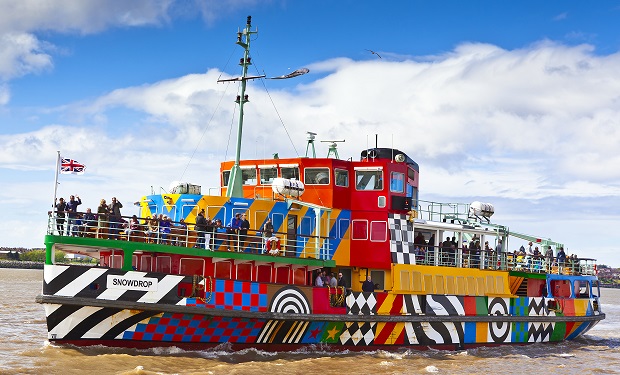
"Snowdrop" in 2015 painted in Sir Peter Blake's "Razzle Dazzle" paint scheme
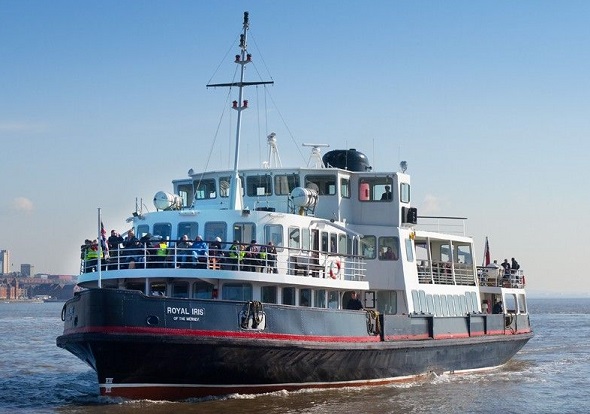
"Royal Iris of the Mersey" in 2018
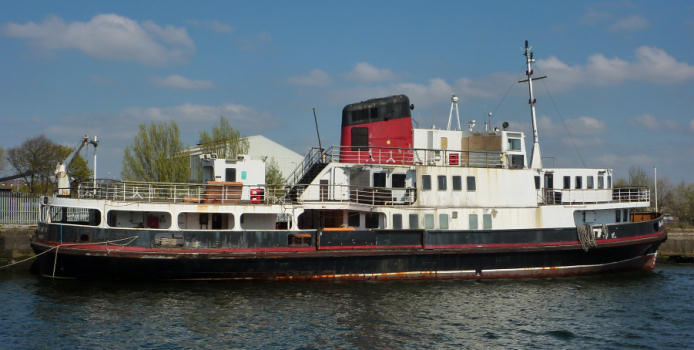
Mothballed "Royal Daffodil" in April 2019 awaiting refurbishment
List of Ferryboats Past and Present
The list below only refers to steam-powered craft, as earlier records of oar and sail craft are very sketchy. The list is not exhaustive and errors may have occurred due to conflicting information from different sources of reference.
|
Key to Details Column |
|
|
Fleet Owner - |
C = Chartered B = Birkenhead W = Wallasey O = Other |
|
Type - |
P = Passenger L = Luggage C = Collier D = Dredger |
|
Propulsion - |
SP = Steam/Paddle SS = Steam/Screw DES = Diesel/Electric/Screw DS = Diesel/Screw |
|
Dates in Service |
Name |
Details |
Comments |
|
|
From |
To |
|||
|
1817 |
1817 |
“Etna” |
C-P-SP |
Experimental, twin-hulled, centre-paddle |
|
1820 |
1820 |
“Gem” |
C-P-SP |
Experimental craft |
|
1822 |
? |
“Royal Mail” |
C-P-SP |
Joint first steam ferryboat |
|
1822 |
? |
“Seacombe” |
B-P-SP |
Joint first steam ferryboat |
|
1823 |
? |
“Versuvius” |
W-P-SP |
|
|
1824 |
? |
“Alice” |
W-P-SP |
|
|
? |
? |
“Fairy Queen” |
B-P-SP |
|
|
? |
? |
“Gypsy Queen” |
B-P-SP |
|
|
? |
? |
“Ant” |
O-P-SP |
|
|
? |
? |
“Bee” |
O-P-SP |
|
|
? |
? |
“Wasp” |
O-P-SP |
|
|
? |
? |
“Mayfly” |
O-P-SP |
|
|
? |
? |
“Firefly” |
O-P-SP |
|
|
1830 |
? |
“Kingfisher” |
?-P-SP |
|
|
1830 |
? |
“Loch Eck” |
W-P-SP |
|
|
1830 |
? |
“Liverpool” |
W-P-SP |
|
|
1831 |
? |
“John Rigby” |
W-P-SP |
|
|
1832 |
? |
“Hero” |
W-P-SP |
|
|
1834 |
? |
“Sir John Moore” |
W-P-SP |
|
|
1835 |
? |
“Admiral” |
W-P-SP |
|
|
1836 |
? |
“Eisenhower” |
W-P-SP |
|
|
1837 |
? |
“Egremont” |
W-P-SP |
Renamed “Jenny Lind” in 1849 |
|
1837 |
? |
“Cheshire Witch” |
?-P-SP |
|
|
1839 |
? |
“Duke” |
W-P-SP |
|
|
1840 |
? |
“Elizabeth” |
W-P-SP |
|
|
1841 |
? |
“Sir Thomas Stanley” |
W-P-SP |
|
|
1845 |
? |
“Queen of Beauty” |
W-P-SP |
|
|
1845 |
? |
“Thomas Wilson” |
W-P-SP |
|
|
1845 |
? |
“Invincible” |
W-P-SP |
|
|
1846 |
? |
“James Atherton” |
W-P-SP |
|
|
1847 |
? |
“Lord Morpeth” |
W-P-SP |
|
|
1847 |
? |
“Wallasey” |
W-P-SP |
|
|
1849 |
? |
“Fairy” |
W-P-SP |
|
|
1853 |
? |
“Britannia” |
W-P-SP |
|
|
1853 |
? |
“Ramsgate Packet” |
W-P-SP |
|
|
1857 |
? |
“Tiger” |
W-P-SP |
|
|
1861 |
? |
“Thomas Royden” |
W-P-SP |
|
|
1861 |
? |
“Gem” |
W-P-SP |
|
|
1862 |
? |
“Water Lily” |
W-P-SP |
|
|
1862 |
? |
“May Flower” |
W-P-SP |
|
|
1862 |
? |
“Wild Rose” |
W-P-SP |
|
|
1863 |
? |
“Cheshire” |
B-P-SP |
|
|
1863 |
? |
“Heather Belle” |
W-P-SP |
|
|
1865 |
? |
“Lancashire” |
B-P-SP |
|
|
1865 |
? |
“Woodside” |
B-L-SP |
Renamed “Shamrock” in 1891 |
|
1867 |
? |
“Maggie” |
W-C-SS |
|
|
1872 |
? |
“Swallow” |
W-P-SP |
|
|
1872 |
? |
“Seymour” |
W-P-SP |
|
|
1877 |
? |
“Prince of Wales” |
B-P-SP |
|
|
1877 |
? |
“Queen of the Mersey” |
B-P-SP |
|
|
1879 |
? |
“Oxton” |
B-L-SS |
Re-named “Old Oxton” in 1925 |
|
1879 |
1905 |
“Sunflower” |
W-L-SP |
Rebuilt as passenger craft |
|
1879 |
? |
“Daisy” |
W-P-SP |
|
|
1880 |
? |
“Bebington” |
B-L-SS |
First screw passenger ferry |
|
1880 |
? |
“Birkenhead” |
B-P-SP |
|
|
1880 |
? |
“Primrose” |
W-P-SP |
|
|
1881 |
? |
“Wallasey” |
W-L-SS |
|
|
1883 |
? |
“Violet” |
W-P-SP |
|
|
1884 |
? |
“Tranmere” |
B-L-SS |
|
|
1884 |
? |
“Crocus” |
W-P-SS |
|
|
1884 |
? |
“Snowdrop” |
W-P-SS |
|
|
1889 |
? |
“Cheshire” |
B-P-SP |
|
|
1890 |
? |
“Mersey” |
B-P-SS |
|
|
1890 |
1890 |
“Alexandra” |
C-P-SP |
Chartered for one year |
|
1890 |
1890 |
“Queen” |
C-P-SP |
Chartered for one year |
|
1891 |
? |
“Thistle” |
W-P-SP |
|
|
1891 |
? |
“Shamrock” |
W-L-SP |
Ex-Birkenhead vessel “Woodside” |
|
1894 |
? |
“Birkenhead” |
B-P-SP |
|
|
1895 |
? |
“Emily” |
W-C-SS |
|
|
1896 |
? |
“John Herron” |
W-P-SP |
|
|
1896 |
? |
“Pansy” |
W-P-SP |
|
|
1897 |
? |
“Pearl” |
B-P-SP |
|
|
1897 |
? |
“Ruby” |
B-P-SP |
|
|
1897 |
? |
“Sapphire” |
B-P-SP |
|
|
1898 |
? |
“Tulip” |
W-D-SS |
Used at New Brighton stage |
|
1899 |
? |
“Lancashire” |
B-P-SS |
|
|
1899 |
? |
“Claughton” |
B-P-SS |
Re-named “Old Claughton” in 1930 |
|
1900 |
? |
“Rose” |
W-P-SS |
|
|
1901 |
? |
“Lily” |
W-P-SS |
|
|
1901 |
? |
“Seacombe” |
W-L-SS |
|
|
1903 |
? |
“Bidston” |
B-P-SS |
Re-named “Old Bidston” in 1933 |
|
1903 |
? |
“Woodside” |
B-P-SS |
|
|
1906 |
1936 |
“Iris” |
W-P-SS |
Renamed “Royal Iris” in 1918 |
|
1906 |
1933 |
“Daffodil” |
W-P-SS |
Renamed “Royal Daffodil” in 1918 |
|
1906 |
? |
“Prenton” |
B-L-SS |
|
|
1910 |
? |
“Storeton” |
B-P-SS |
|
|
1910 |
1936 |
“Bluebell” |
W-P-SS |
Renamed “John Joyce” - date unknown |
|
1910 |
? |
“Snowdrop” |
W-P-SS |
|
|
1921 |
1939 |
“Churton” |
B-L-SS |
|
|
1921 |
1939 |
"Barnston” |
B-L-SS |
|
|
1921 |
1946 |
“Liscard” |
W-L-SS |
|
|
1921 |
1948 |
“Leasowe” |
W-L-SS |
|
|
1922 |
1952 |
“J Farley” |
W-P-SS |
|
|
1922 |
1951 |
“Francis Storey” |
W-P-SS |
|
|
1925 |
1946 |
“Upton” |
B-P-SS |
Shallow draught for Rock Ferry Service |
|
1925 |
1956 |
“Hinderton” |
B-P-SS |
Chartered to Wallasey in 1950 |
|
1927 |
1963 |
“Wallasey” |
W-P-SS |
Last steam powered Mersey ferryboat |
|
1927 |
1958 |
“Marlowe” |
W-P-SS |
|
|
1929 |
1953 |
“Perch Rock” |
W-L-SS |
|
|
1930 |
1961 |
“Claughton” |
B-P-SS |
|
|
1930 |
1961 |
“Thurstaston” |
B-P-SS |
|
|
1932 |
1956 |
“Royal Iris II” |
W-P-SS |
First triple-decker, renamed “Royal Iris” in 1947 and “St Hilary” in 1950 |
|
1933 |
? |
“Emily II” |
W-C-SS |
|
|
1933 |
1960 |
“Bidston” |
B-P-SS |
Chartered to Cork Harbour Commission |
|
1934 |
1962 |
“Royal Daffodil II” |
W-P-SS |
Renamed “St Hilary” in 1957 |
|
1949 |
1953 |
“Channel Belle” |
W-P-DS |
Renamed “Wallasey Belle” in 1950 |
|
1951 |
1974 |
“Leasowe” |
W-P-DS |
Renamed “Naias II”, later “Cavo Doro” |
|
1952 |
1975 |
“Egremont” |
W-P-DS |
Now, Island Cruising Club in Salcombe |
|
1951 |
1990 |
“Royal Iris” |
W-P-DES |
Built by Denny’s of Dumbarton and nicknamed “Fish and Chip Boat” or “Booze Boat” |
|
1958 |
1977 |
“Royal Daffodil II” |
W-P-DS |
Built by Philip and Sons of Dartmouth, and renamed “Ioulis Keas II” when sold |
|
1960 |
P/D |
“Woodchurch” |
B-P-DS |
Built by Philip and Sons of Dartmouth and twin to the “Mountwood”, refitted and renamed "Snowdrop" in 2004 |
|
1960 |
P/D |
“Mountwood” |
B-P-DS |
Built by Philip and Sons of Dartmouth and twin to the “Woodchurch”, refitted in 2001 and renamed “Royal Iris of the Mersey” in 2002 |
|
1962 |
P/D |
“Overchurch” |
B-P-DS |
Built by Cammell Lairds to the same plans as the “Phillips’ Twins” but with some modifications and was the first Mersey Ferryboat of all welded construction. Refitted and renamed “Royal Daffodil” in 2000. Moth-balled in 2013 and in 2019 dry-docked, refurbished then moved to Canning Dock, Liverpool as a tourist attraction |
|
1982 |
1982 |
“Highland Seabird” |
C-P-DS |
Experimental high-speed catamaran |
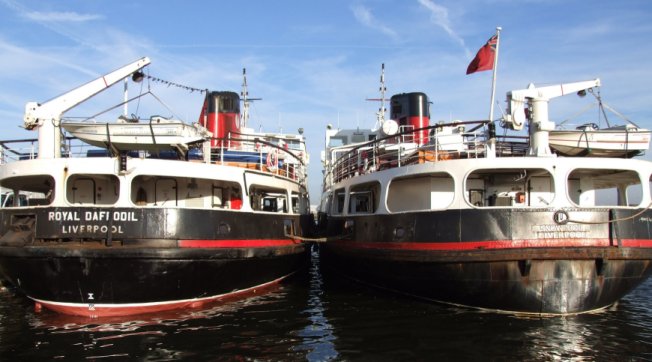
The "Royal Daffodil" and "Snowdrop" moored at Duke Street Bridge in Wallasey Pool
Over the years, the Mersey Ferries have met every threat to their existence and survived. The days of people commuting to and from Liverpool en-mass are over but the Wallasey/Liverpool service is still in operation at rush hours. During the remainder of the day, a triangular route from Wallasey/Woodside/Pier Head including a trip upstream past Tranmere Oil Terminal and downstream as far as New Brighton (weather permitting) is offered as a "River Explorer" service. In the winter months the trip downstream is normally as far as just past Egremont. Even though the days where passengers would travel to Seacombe, Egremont and New Brighton on summer weekends and Bank Holidays have gone, the ferries are now one of the area’s premier tourist attractions. Trips are regularly offered along the Manchester Ship Canal to Salford Quays with a return journey by coach.
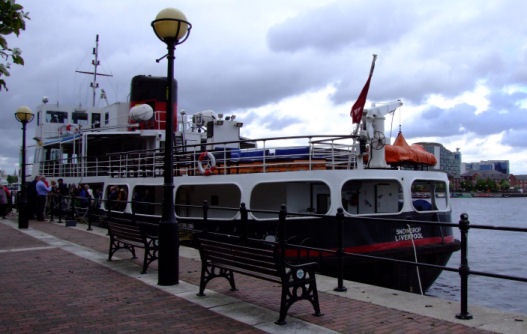
"Snowdrop" moored at Salford Quays on the Manchester Ship Canal
Periodically, plans for a new ferry terminal at New Brighton are proposed but, alas, do not amount to anything. There are also plans in the pipe-line for new craft to replace the ageing boats currently in service. Let us hope that the funding for this historic service remains for at least another thousand years allowing the continuing existence of the historic ferries across the River Mersey.
Updated - 17/04/2019